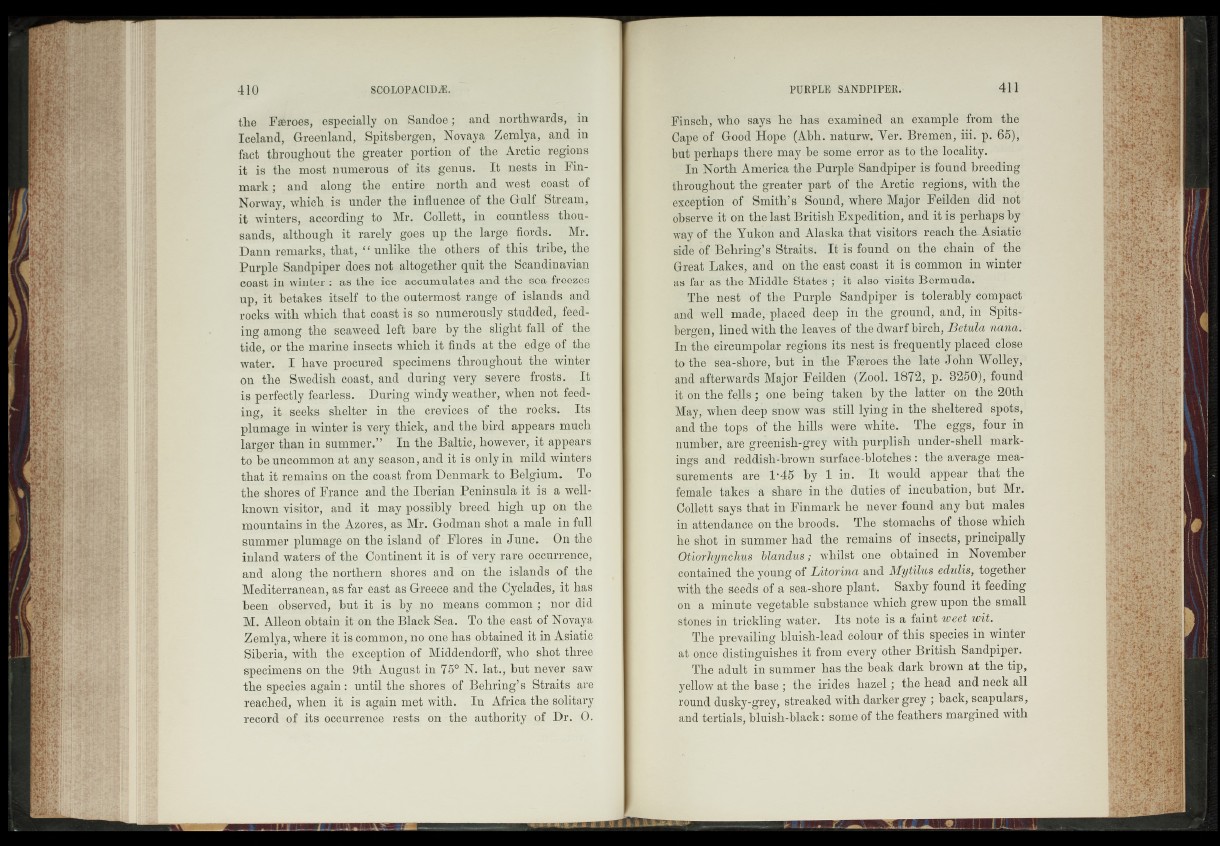
the F&roes, especially on. Sandoe; and northwardsin
Iceland, Greenland, Spitsbergen; ^ffovaya Zemlya, and in
fact throughout the greater portion of the Arctic regions
it is the most numerous of its genus. It nests in ^in-
mark; and along the entire north and west. -coast-of
NorWay, which, is under the influence of ./the Go,lf^ Stream,
it winters, according to Mr. Collett, in countless thousands,
although it rarely goes up the large' fiord#.; 1 Mr.
Dann remarks, that, “ unlike the others; tribe, the
Purple Sandpiper does not altogether qfuit the Scandinavian
coast in winter : as the ice jj accumulates and,the saajj|eiezes
up,' it betakes itself to the outermost range oh islapds and
rocks with which that coast is .go numerouslytgt u dded,3Reding
among the seaweed deft. Jbarg by-the slight fall-vqfe^gB
tide, or the marine insects which it finds at .-the edgc ftf the
water. I have procured specimens, thj:9ughqut] ,the -wjpter
on the Swedish coast, and during - ygry .geygge t;frpsts., It
is perfectly feajl§s$- During.windy weather, when-n^feed-
ing, feeks shelter ip thes gre.yic.es ,.;(A»the rocjks:, Its.
plumage in winter is very.th i^ ^ n ^ ,,th 6 hird appears- much
larger than in summer.” In the Baltic, however,^.appears
to be uncommon-.at any season, and it is only in pqild (winters
that it remaing on the ,cpagtwf|opr©^n}^k.t1Q Belgium. To
the shores of^France^ Iberian,Penip£ulg{itT i | a ||gllknown
yisitor, and . it ..maypossiblv. breed , high,'up
mountains,mTthe Azores, ag Mr. Rodman:s Jagt a-male,;ip fg&l
summer plumage op-the.fjilggd cjfx,|fIores. 4n Jnhe,^; O n d ^
inland y^terg pf thp^ont^pept -it is p%^^ra^%40c ^ r |^ |^ ,t
and along-'the northern shpre^and p n .d ^ islands of-the
Mediterranean, as far east^as Greecp^and -the rCyel.adesilillas;
been observed, means common, ;t giigr did
M. Alleqp 50bf^n'firpn the Black Sea.' Yo^th1' i nt. \<p i\ i
Zemlya, where itisb©mmon, np ;^ fb a s obtained, %,ip Agj^jkic
Siberia, with’r,j^ejLgxception of Middendorff, ybp .shot ^hree
specimens on the -@thr Apairat in 7 q?>^ ^ lat., but npyer saw
the species again: unt^rwp gliqres^ of Behring’s fi[trait§.jgre
reached, when [it - is> again- metnwjith^ f Jn Africa the solitary
record of its. occurrence rests, on-the authc^ty^gf
Finsch', who says he 'has examined an example from the
Cape of ;Good flope (Abh. naturw. Yer. Bremen, iii.‘ p.-65),
but perhaps there may be some error as to the locality.
In Nofth A‘merica4he Purple1 Sandpiper is found breeding
throughout the greater part of the Arctic regions--with-the
exception of Smith’s Sound, where Major Feilden did5'hetr
observe it on thefiafst British Expedition, hnd it is perhaps by
way of-the Yukon and Alaska that visitors reach. the_Asiatic
side df* Behring’s' Straits; It is found 6?f the chain o f the
Great Lakes, and on the east coast -it ^ c om m o n winter
as fa fd s dhe-Middle " S f a t^ 'd t also visits’Bhrmuda.
»‘-‘The nest of the Purple‘'Sandpiper is-'tolerably compact
add well made, placed deep' -in the- -ground, and, in^Spifs-'
bergen, lined with the leay,es,o,f the dwarf birch, p gMia- nafm-
Inb’he eirciimpolar regions its ^081-18'frequeri-tly placed- close
td-^e4' sea- shore, butf1 in the T’feroes* the d?atb tlohn 'Wcll-ly,5
and afterwards Major Feilden 8 d l^ ;8l^7rP■ ^2fS©yiTfound
it MdheYelli^;:'bne Seing- 'tdken- by'dhe latilab on tKfe:20th-
May,lwhen'deep iribd' was S’titf lying in - the' -sheltered ispbi^,-
and the tops >fot the. hills were white. The -eggs« fourin
number,rfare greenish ^gife-y f/ith purplish uuder-shell markings
»find«reddlsb-brown WrfMb-blitcheS : the :aYera'ge- smea-
sukmbntV are l in. I t' would ’appear that' ;'the
Ufoale -takes a -share-bn the* duties^ o#fnMbatldn-bbuf Mr.'
^o'llett says-that ffa Finmark he never • f o u n d r y but -males
inAattendance on the broods. The stomachs of those which
'h%'shot in summer had' the remains df^ inseefs, principally
Otlorhynchji'i blandus; whilst one obtained in November
„ contained the \oung of Litorina and Alytilus edulis, together
wftji the sied^amf^a sea-shore plant. Saxby foundrit feeding
a minutc\tegetablo' substance‘which grew upon the small
Jldneg ip. trickling water. Jts"n‘ote'4^a fainj^g^i wit.
C* Tlie prevailing bluigh-lead c'blour of this species in winter
a^once distinguishes it from every other British Sandpiper.
The aduiljn^summer has the bpak dark b|own at the tip,
j^ u llnw .it ily base; ibeSirides liazel; the head and.ncdk all
«rpimd dusky-i^fe^streaked with darker grey ; hack, scapulars,
-'and tertials; bluish-black :- some.of the feathers margined \^th